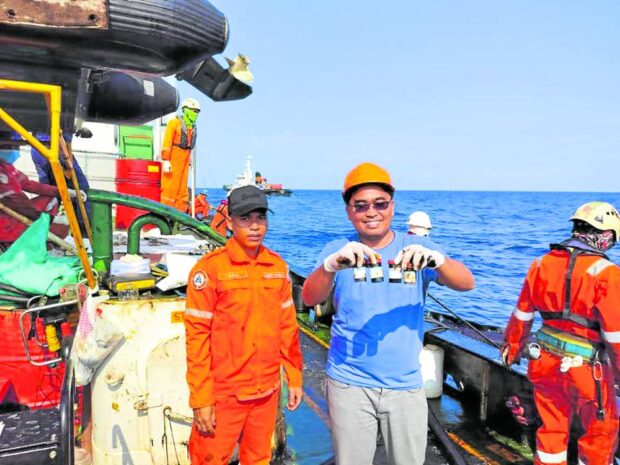
GATHERING EVIDENCE | Scientist Hernando Bacosa (in blue shirt) and a member of the Philippine Coast Guard show samples gathered from shorelines that may have been affected by the oil spill from the sunken motor tanker MT Princess Empress. (Photo by HERNANDO BACOSA / Contributor)
MANILA, Philippines — Palawan scientist Hernando Bacosa, who has studied the effects of an oil leak on the ocean for nearly a decade, thinks a spill site is much like a crime scene.
This is particularly true regarding the oil spill off the coast of Naujan, Oriental Mindoro province, where 800,000 liters of industrial oil continue to leak since the MT Princess Empress, a tanker operated by RDC Reield Marine Services, which sank there almost two months ago, on Feb. 28.
Just as a detective can search for prints at a crime scene, so, too, can scientists detect an oil spill’s “fingerprints” to see if slicks found beyond the spill site came from the original location.
This process, called chemical fingerprinting, is significant for the affected communities who may consider seeking damages, Bacosa said.
So while authorities try to contain the fallout, his work could lay the groundwork for environmental justice for the fisherfolk of Oriental Mindoro.
“For example, if you found oil as far as Palawan and you are sure that this oil came from the tanker, in court you have a strong case to claim for damages and for compensations and economic losses,” he told the Inquirer.
‘Emergency oil response’
In an effort to show authorities the extent of the spill, Bacosa has so far collected oil residues on the shorelines of Palawan (some 445 kilometers from Mindoro Island), the Cuyo Islands (254 km) which are part of that province, Semirara Island (27.5 km) and Batangas province (60 km).
Some of the samples were sent to Japan and France — countries that have the equipment necessary for fingerprinting.
Samples collected from the town of Pola in Oriental Mindoro have been found “positive” by Cedre, which is described on its website as a French “nonprofit association” with “expertise in accidental water pollution.”
The Philippine Coast Guard (PCG), which is tasked with the huge challenge of containing the spill, has has availed itself of Bacosa’s expertise through the Department of Science and Technology (DOST). On March 17, PCG Vice Adm. Robert Patrimonio wrote Science and Technology Secretary Renato Solidum in March, seeking his agency’s assistance in examining oil samples taken by the PCG in Mindoro, Semirara, and Taytay town, Palawan.
It is surprising, as Bacosa has noted, that the DOST was not among the agencies included in the government’s National Oil Spill Contingency Plan, drawn up in the wake of the sinking of the MT Princess Empress.
That is why President Ferdinand Marcos Jr. himself asked Bacosa last month “if I could help in the crafting of amendments that would include the DOST in the emergency oil response,” recalled the scientist.
Biomarkers
A 2018 fellow of the DOST’s Balik Scientist Program, Bacosa is currently a professor of environmental science at the Iligan Institute of Technology of Mindanao State University.
He was one of the scientists involved in the chemical fingerprinting of the Deepwater Horizon oil spill in 2010, which saw 4.4 million barrels of oil spread in the Gulf of Mexico.
Bacosa explained that fingerprinting is possible because of biomarkers in petroleum—which are complex molecules that tend to resist “degradation” and “weathering.”
In other words, he said, these markers will show up on oil samples, no matter how far or how long ago they were obtained.
Fingerprinting also helps in tracking changes in the chemical composition of the oil sample, Bacosa said.
For example, freshly spilled oil tends to be more soluble and more toxic, as this can be ingested by phytoplanktons and zooplanktons, thus disrupting the food chain in the affected marine ecosystem.
When exposed to oil, aquatic animals often suffer stunted growth, enlarged livers, and weakened hearts, Bacosa said. This is especially damaging to fisherfolk who depend on those species. Bacosa noted that oil spill science in the Philippines “is really superficial despite [its] being a maritime country.”
He said chemical fingerprinting itself is not too complex. But the country still does not have the technological capability and skill for that expertise.
“[That is] why even though the Coast Guard works really hard in containing the spill, there is only so much they can do,” Bacosa said. “Plus, nobody is yet doing the assessments on the extent of ecological damage [that the spill] brought to the environment.”
He called for a more holistic approach to managing calamities, including regular consultations with scientists who could help provide a clearer picture of their magnitude.